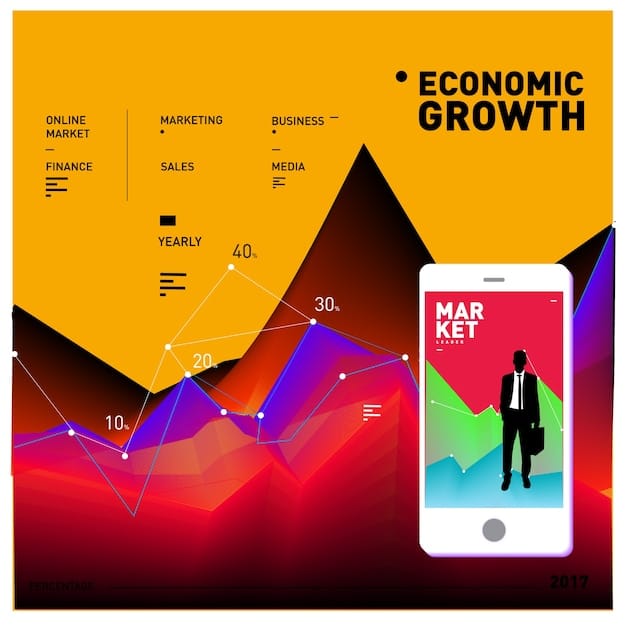2025 Podcast Ad Guidelines: Revenue Impact & Strategy

The updated 2025 podcast advertising guidelines, primarily focusing on advanced impression measurement, audience targeting, and content transparency, are poised to significantly reshape revenue streams for podcast creators and advertisers alike, demanding strategic adaptation for sustained growth and profitability.
As the podcast industry continues its meteoric rise, an often-overlooked yet critical component of its ecosystem is undergoing significant evolution: advertising guidelines. The forthcoming updated 2025 Podcast Advertising Guidelines promise to be more than just a regulatory update; they represent a pivotal shift with the potential to profoundly impact how podcast creators, networks, and advertisers generate and manage revenue. Understanding these changes isn’t just a matter of compliance; it’s an imperative for strategic planning and unlocking new opportunities in a rapidly maturing medium.
Understanding the Core of the 2025 Guidelines
The 2025 Podcast Advertising Guidelines are not merely incremental adjustments; they represent a foundational rethinking of how podcast advertising is measured, transacted, and ultimately valued. At their heart, these updates aim to standardize metrics, enhance transparency, and foster greater trust within the burgeoning podcast advertising ecosystem. This push for clearer standards is driven by the industry’s desire to attract larger brand budgets and compete more effectively with established digital advertising channels.
One of the most significant shifts involves the refinement of impression measurement. While historical metrics often focused on downloads, the new guidelines place a stronger emphasis on “listens” or “plays” that meet specific duration criteria, providing a more accurate representation of actual consumption. This move is critical for advertisers who seek verifiable engagement, rather than just raw download numbers. It also influences how inventory is priced, potentially leading to higher CPMs (Cost Per Mille) for verified, engaged listeners.
Enhanced Impression Measurement
The updated guidelines introduce a more rigorous approach to defining a “measurable impression,” moving beyond simple downloads. This includes criteria such as minimum listen duration and stricter bot filtration. For podcasters, this means that while raw download numbers might appear lower, the quality of reported impressions will be significantly higher, which can justify premium pricing.
- Duration-Based Metrics: Impressions will likely be counted only after a listener has consumed a set percentage or duration of an episode, such as 60 seconds or 50% of the content.
- Advanced Bot Detection: Robust technologies will be mandated to filter out non-human traffic, ensuring that advertisers are paying for genuine human engagement.
- Geographic and Demographic Granularity: More precise data on listener locations and demographics will be available, enabling highly targeted campaigns.
The impact on revenue is multi-faceted. Podcasters who consistently deliver engaged audiences, as defined by these new metrics, stand to benefit from increased advertising rates and more demand from premium brands. Conversely, those with inflated download numbers but low engagement might see a decline in perceived value and, consequently, advertising revenue. It’s a clear signal that quality and listener retention are paramount.
These standards also aim to combat ad fraud, a growing concern across all digital media. By creating a more transparent and verifiable system, the industry hopes to build advertiser confidence, encouraging larger investments. Podcasters should prepare to demonstrate their audience engagement through these refined metrics, possibly investing in analytics tools that align with the new reporting standards.
Content Transparency and Disclosure
Another critical aspect of the 2025 guidelines centers on content transparency, particularly regarding native advertising, sponsored content, and host-read ads. The Federal Trade Commission (FTC) in the US has consistently emphasized the importance of clear disclosures in all forms of advertising, and these new guidelines bring podcasting further into alignment with these expectations.
- Clear Sponsorship Disclosures: Whether it’s a pre-roll, mid-roll, or post-roll ad, or even an entire sponsored episode, clear and audible disclosures will be mandatory.
- Native Content Tagging: Podcasts integrating branded content seamlessly within their narratives will need explicit labeling to differentiate it from organic editorial content.
For podcasters, this means revisiting their ad insertion practices and ensuring their hosts are adequately trained on proper disclosure protocols. Failure to comply could result in fines, reputational damage, and loss of advertiser trust. While some might view this as an added burden, it ultimately protects the integrity of the podcast medium, preventing listener fatigue or backlash from feeling deceived. Transparent practices build long-term loyalty, which is invaluable for recurring revenue.
Ultimately, the core of the 2025 guidelines revolves around establishing a more mature and professional advertising marketplace. By providing advertisers with more reliable data and ensuring ethical disclosure, the industry aims to unlock a new wave of ad spending, benefiting podcasters who embrace these changes proactively.
Implications for Podcast Creators and Networks
The updated guidelines will undoubtedly reshape the operational and strategic landscape for podcast creators and networks. It’s not simply about tweaking existing practices but rather fundamentally re-evaluating how content is produced, audiences are engaged, and advertising partnerships are forged. The focus shifts from raw reach to genuine engagement and measurable value, demanding a more sophisticated approach to monetization.
For independent podcasters, adapting to these guidelines might require investing in better analytics tools or partnering with networks that can provide such capabilities. Understanding audience demographics and listening habits with greater precision will become essential for selling ad inventory effectively. Networks, on the other hand, will need to develop standardized reporting frameworks that comply with the new measurement criteria, offering their creators valuable insights and actionable data.

Adapting to Advanced Measurement Metrics
The move towards more advanced impression measurement, as outlined by the guidelines, necessitates a paradigm shift for podcasters. The days of simply reporting total downloads are fading; instead, the emphasis will be on validated, engaged listenership. This pushes creators to focus intensely on retention strategies and content quality.
- Content Optimization: Producing more compelling, higher-quality content that encourages listeners to stay tuned for longer durations will directly translate into higher measurable impressions.
- Audience Segmentation: Leveraging advanced analytics to understand who is listening, where they are geographically, and their interests will become crucial for attracting advertisers seeking specific demographics.
- Analytics Tool Adoption: Podcasters and networks will need to adopt or upgrade their analytics platforms to capture, process, and report data according to the new standards, particularly focusing on listen-through rates and geo-targeted engagement.
Revenue models may also shift. CPMs could become more nuanced, with premium rates for highly engaged, verified audiences. Podcasters who can consistently demonstrate high listen-through rates and specific demographic reach will command higher prices for their ad slots. This encourages an ecosystem where meaningful engagement is rewarded, moving away from volume-based metrics that may not reflect true value.
The transition may initially present a challenge, particularly for smaller creators who lack robust analytics infrastructure. However, the long-term benefit is a more robust, trustworthy marketplace where genuine engagement is adequately valued. Networks are well-positioned to assist their creators in this transition, providing shared tools and expertise to navigate the complex new data landscape.
Navigating Transparency and Disclosure Requirements
Beyond measurement, the enhanced transparency and disclosure rules present another critical area of adaptation. While the spirit of disclosure has always been present, the 2025 guidelines likely formalize and standardize these practices across the industry. This is crucial for maintaining listener trust and avoiding regulatory backlash.
For creators, this means embedding clear, unambiguous disclosures for all sponsored content and brand partnerships. This could range from specific language read by the host at the start or end of an ad segment to visual cues in accompanying show notes or podcast app interfaces. The goal is to ensure listeners can readily distinguish between editorial content and paid promotions.
Networks will play a vital role in educating their talent and affiliates on best practices for disclosure. Training modules, standardized scripts, and regular compliance checks may become standard operating procedures. While this may initially feel restrictive, it safeguards the authenticity of the podcast–listener relationship, which is a core strength of the medium.
The impact on revenue is primarily about risk mitigation and long-term viability. A reputation for transparency builds trust with both listeners and advertisers. Brands are increasingly sensitive to consumer perception and are more likely to partner with creators and networks that adhere to high ethical standards. Conversely, failures in disclosure can lead to penalties, public backlash, and a swift loss of advertising partners, directly impacting revenue.
Ultimately, these guidelines push the industry towards greater professionalism. For podcast creators and networks, adapting successfully means embracing data-driven decision-making, prioritizing audience engagement, and upholding the highest standards of transparency. Those who navigate these changes effectively will be best positioned to thrive and expand their revenue streams in the evolving podcast landscape.
Opportunities for Advertisers and Brands
The updated 2025 Podcast Advertising Guidelines don’t just present challenges for creators; they unlock significant opportunities for advertisers and brands looking to invest in the medium. By standardizing metrics and enhancing transparency, these guidelines aim to de-risk podcast advertising, making it a more attractive and measurable channel for marketing spend. Brands are consistently seeking channels that offer verifiable ROI, and these new standards are designed to deliver just that.
For brands, the enhanced data availability means they can deploy their ad budgets with greater confidence, knowing that impressions are genuinely measured and audiences are accurately segmented. This precision allows for more effective campaign planning, improved targeting, and ultimately, a better return on advertising investment (ROAS).
Improved Targeting and ROI Measurement
The refinement in impression measurement and audience data granularity is a game-changer for advertisers. Moving beyond broad listener statistics, brands will have access to richer, more reliable data points to refine their targeting strategies.
- Precision Targeting: Advertisers can now target listeners not just by podcast genre, but by verified demographics, geographic locations, and even specific listening behaviors within an episode.
- Advanced Attribution: With more standardized data, brands can more accurately attribute conversions and sales directly to podcast campaigns, demonstrating clear ROI and justifying increased budget allocation.
- Cross-Platform Integration: The new metrics facilitate better integration of podcast ad data with other digital marketing channels, enabling holistic campaign analysis.
This level of precision translates directly into more efficient ad spend. Brands can minimize wastage by ensuring their messages reach the most receptive audience segments. For instance, a local business can confidently invest in a podcast if they know they can reach listeners specifically within their service area, rather than relying on broader national or international reach.
The ability to accurately measure ROI is perhaps the greatest boon for advertisers. When marketing teams can demonstrate a clear link between podcast ad spend and tangible business outcomes (e.g., website traffic, lead generation, sales), it becomes easier to secure larger budgets for future campaigns. This ultimately drives more ad dollars into the podcast ecosystem, benefiting creators and networks alike.
Building Trust and Brand Safety
Transparency and robust measurement standards are paramount for building advertiser trust and ensuring brand safety. In an age where brands are increasingly cautious about where their ads appear and what content they are associated with, the 2025 guidelines provide much-needed reassurance.
- Reduced Ad Fraud: Stricter bot detection and impression validation reduce the risk of ad fraud, meaning brands are paying for genuine human eyeballs and ears.
- Enhanced Brand Suitability: Clear disclosure requirements and better content tagging allow brands to make more informed decisions about which podcasts align with their values and brand image.
- Long-Term Partnership Potential: A more transparent and reliable advertising environment fosters stronger, long-term partnerships between brands and podcast creators/networks, moving beyond one-off campaigns to sustained collaborations.

For brands, the confidence derived from these updated guidelines means they can experiment more boldly with podcast advertising knowing that their investment is protected and their brand reputation is safe. This makes podcasting a more attractive, less risky proposition compared to certain unregulated corners of the digital advertising world.
The symbiotic relationship between creators and advertisers will only strengthen under these new conditions. Advertisers gain more reliable insights and a safer environment, while creators benefit from increased ad spending and a more professional marketplace. Those brands that proactively understand and leverage these guideline updates will gain a significant competitive advantage in reaching highly engaged podcast audiences.
Potential Challenges and How to Overcome Them
While the updated 2025 Podcast Advertising Guidelines offer a clear path towards a more mature and valuable advertising ecosystem, their implementation won’t be without challenges. Both podcast creators and advertisers will need to navigate new complexities, invest in different areas, and potentially adjust existing workflows. Anticipating these hurdles and developing proactive strategies to overcome them will be key to successful adaptation.
For creators, the immediate challenge might be the initial investment in new analytics tools or the learning curve associated with advanced data reporting. Advertisers, meanwhile, might need to reconsider their current pricing models and campaign attribution frameworks. However, these challenges are surmountable with strategic planning and a willingness to embrace change.
Initial Investment and Adaptation Curve for Podcasters
The shift towards more rigorous measurement and reporting standards will likely require an initial investment from podcast creators, particularly independent ones, or smaller networks.
- Technology Upgrades: Implementing or upgrading to analytics platforms that can provide detailed, compliant data (e.g., listen-through rates, verified impressions, precise audience demographics) will be necessary. This often comes with a cost.
- Operational Adjustments: Teams might need training on new reporting protocols, and workflows for ad insertion and disclosure will require standardization. This includes ensuring hosts are consistently adhering to disclosure guidelines.
- Monetization Model Review: Some podcasters might see a temporary dip in reported “impressions” as unverified downloads are filtered out, necessitating a re-evaluation of their pricing strategies and value propositions to advertisers.
To overcome these, podcasters should: research and adopt scalable analytics solutions that fit their budget; seek educational resources from industry bodies or service providers on new compliance requirements; and focus on consistently producing high-quality content that naturally drives listened impressions. Collaboration with larger networks or advertising partners who can provide integrated solutions may also ease the transition.
For networks, the challenge escalates to implementing these changes across a diverse roster of shows, potentially requiring significant infrastructure investment and extensive training programs for their creators. However, networks that lead in compliance will attract more premium advertisers, ultimately justifying the upfront investment.
Advertiser Learning Curve and Data Interpretation
Advertisers, while benefiting from richer data, will also face a learning curve in interpreting and leveraging these new metrics. The shift from anecdotal success or simple download numbers to granular, engagement-based performance indicators requires a more sophisticated approach to media buying and campaign analysis.
- New Metric Understanding: Marketing teams will need to thoroughly understand what constitutes a “verified impression” or a “qualified listen,” moving beyond familiar metrics from other digital channels.
- Attribution Model Refinement: Existing attribution models may need adjustments to properly credit podcast advertising in a multi-touch attribution framework, given the new data inputs.
- Creative Adaptation: With more precise targeting available, advertisers may need to adapt their ad creative to be highly relevant to specific audience segments identified through the new data, moving beyond a one-size-fits-all approach.
To mitigate these challenges, advertisers should: invest in training for their media buying teams on the new podcast advertising standards; collaborate closely with podcast networks and creators to understand available data and best practices; and experiment with different campaign structures and ad creatives to optimize performance under the new guidelines.
Overall, while the road to full implementation of the 2025 guidelines might have its bumps, the benefits of a more standardized, transparent, and measurable podcast advertising ecosystem far outweigh the initial challenges. Proactive engagement and a willingness to adapt will differentiate those who thrive in this evolving environment.
Strategic Adaptation for Sustained Revenue Growth
For podcast creators and networks seeking to not just survive but thrive under the updated 2025 Podcast Advertising Guidelines, strategic adaptation is paramount. This involves moving beyond mere compliance to proactively leveraging the new landscape for sustained revenue growth. The emphasis shifts from simply “doing” podcasting to “optimizing” it as a valuable media property.
This strategic approach encompasses refined content creation, sophisticated audience engagement, and innovative monetization methods that fully capitalize on the enhanced data and transparency offered by the new guidelines. It’s about building a robust, future-proof business model for your podcast endeavors.
Content Strategy Refinement
The new emphasis on engaged impressions means that content quality, listener retention, and the ability to attract specific audience demographics become even more critical.
- Vertical Niche Specialization: Instead of broad appeal, consider hyper-focusing on niche topics that attract highly engaged, dedicated, and identifiable audiences. These audiences are highly valuable to advertisers seeking precise targeting.
- Engagement-Driven Content: Design content that encourages longer listening sessions. This could involve multi-part series, interactive elements, or compelling storytelling that keeps listeners hooked. Longer listen-through rates directly impact impression counts.
- Audience Persona Development: Deeply understand your ideal listener. What are their interests, demographics, pain points? This knowledge informs content creation and helps you articulate your value to advertisers seeking that specific audience.
By refining content strategy with these points in mind, podcasters can organically boost their “measurable impressions” and justify higher ad rates. An engaged, loyal audience is an advertiser’s dream, and the new guidelines reward content that cultivates this.
Networks should provide their talent with data-driven insights on what content resonates most effectively with specific demographics, helping creators fine-tune their offerings for optimal advertiser appeal. This collaborative approach enhances the overall value proposition of the network to both creators and brands.
Diversifying Monetization Beyond Traditional Ads
While the guidelines primarily focus on traditional advertising, their underlying principles of data accuracy and audience insight can also unlock diversified revenue streams.
- Premium Content and Subscriptions: Leveraging detailed listener data, creators can identify segments willing to pay for ad-free listening, bonus episodes, or exclusive content, establishing a direct-to-consumer revenue stream.
- Direct Brand Partnerships & Integrations: With more robust audience metrics, podcasters can approach brands directly for bespoke, integrated campaigns that go beyond standard ad reads. This could include sponsored segments, product placements, or even co-created mini-series.
- Merchandise and Live Events: An engaged audience, verified by the new metrics, is more likely to support ancillary revenue streams like merchandise sales or tickets to live shows, further solidifying the business model.
The ability to provide advertisers with reliable first-party data (e.g., from subscribers or survey participants) about a highly engaged audience is a powerful negotiating tool. This type of data, combined with third-party verified impressions, creates an undeniable value proposition.
Embracing Innovation in Ad Formats and Delivery
The future of podcast advertising isn’t static. Creative ad formats and technological advancements in delivery will continue to evolve, and the new guidelines provide a stable foundation for this innovation.
- Dynamic Ad Insertion (DAI) Optimization: Further optimize DAI capabilities to deliver highly targeted, contextually relevant ads based on real-time listener data and segment profiles.
- Programmatic Buying & Selling: The standardization of data will accelerate the growth of programmatic podcast advertising, allowing creators to more efficiently sell inventory and advertisers to automate buying.
- Interactive and Experiential Ads: Explore newer ad formats that leverage the unique, intimate nature of podcasting—e.g., call-to-action ads, interactive polls, or even VR/AR enhanced audio experiences.
By staying abreast of technological advancements and being willing to experiment with new ad formats, podcasters can offer advertisers more compelling and effective ways to reach their audiences, driving demand and increasing revenue opportunities. The 2025 guidelines are, in many ways, an invitation to innovate within a more structured and reliable framework.
Looking Ahead: The Long-Term Impact on the Podcast Industry
The updated 2025 Podcast Advertising Guidelines mark a significant inflection point for the entire podcast industry. Far from being a mere bureaucratic update, these guidelines are poised to fundamentally reshape how the medium is perceived, valued, and monetized in the long term. The ripple effects will extend across creators, advertisers, technology providers, and even listeners, ushering in an era of greater professionalism, transparency, and, ultimately, sustained growth.
This evolution is a natural part of any emerging media landscape maturing and attracting significant investment. Just as television, radio, and digital display advertising have evolved their measurement and ethical standards over decades, podcasting is now embracing its own adolescence with a clear vision for an adult, robust ecosystem. The goal is to maximize potential without compromising the unique intimacy and authenticity that defines the medium.
Elevating Podcast Advertising to Mainstream Status
Perhaps the most significant long-term impact of the 2025 guidelines will be the elevation of podcast advertising to a truly mainstream, institutionalized channel within the broader media buying landscape.
- Increased Brand Confidence: With standardized, verifiable metrics and clear disclosure rules, large-scale brands and media agencies previously hesitant to significantly invest in podcasts will gain the confidence needed to allocate larger portions of their budgets.
- Comparable to Other Media: Podcast advertising metrics will become more directly comparable to those of other digital and traditional media (e.g., digital audio, display, TV), allowing for more seamless integration into major marketing campaigns.
- Attracting New Categories of Advertisers: Industries with high regulatory scrutiny or those typically focused on highly measurable ROI (e.g., finance, healthcare, direct-to-consumer businesses) will find podcast advertising a more viable and attractive option.
This increased confidence and comparability are crucial for unlocking the next wave of ad spending. When media buyers can confidently present podcasting as a reliable and predictable channel with clear ROI, it opens the floodgates for budgets that were previously allocated elsewhere. This broadens the advertiser pool, creating more demand for inventory across the board.
Fostering Innovation and Fair Market Value
A more transparent and data-rich environment inevitably fosters innovation and helps establish fair market value for podcast inventory.
- Data-Driven Innovation: With better data, ad tech companies will innovate faster, developing more sophisticated tools for targeting, attribution, and ad delivery, leading to more effective campaigns.
- Efficient Market Place: Standardized metrics create a more efficient marketplace where buyers and sellers have a clearer understanding of value. This can lead to more equitable pricing for podcasters and better performance for advertisers.
- Quality Over Quantity: The emphasis on engaged listenership will continue to reward high-quality, audience-centric content production, ensuring that the integrity of the podcast medium is maintained and even enhanced. Content creators will be incentivized to produce compelling audio experiences that keep listeners tuning in, directly benefiting the advertiser through higher listener engagement and more accurate listener data. High-quality content organically leads to better performance under the new guidelines.
This environment rewards creativity and authentic connection, ensuring that the unique appeal of podcasting is preserved even as its monetization becomes more sophisticated. The guidelines are a framework for growth, not a constraint on artistic expression.
In conclusion, the 2025 Podcast Advertising Guidelines represent a necessary and beneficial evolution for the industry. While requiring adaptation and investment, they lay the groundwork for a more robust, transparent, and attractive advertising ecosystem. Podcasters who embrace these changes will find themselves better positioned to secure premium advertisers, diversify their revenue streams, and solidify their place in the increasingly competitive audio landscape. Advertisers, in turn, will gain access to a powerful, verifiable channel for reaching highly engaged audiences. The long-term impact will be a more mature, valuable, and ultimately, more expansive podcast industry for everyone involved.
| Key Area | Impact Summary |
|---|---|
| 📊 Impression Measurement | Shift to “listens” over “downloads” for validated engagement, potentially leading to higher CPMs for quality content. |
| 🗣️ Transparency & Disclosure | Mandatory clear disclosures for sponsored content to build trust and ensure ethical practices. |
| 🚀 Revenue Potential | Increased brand confidence and investment due to better data and reduced ad fraud, opening new revenue streams. |
| 📈 Strategic Adaptation | Requires content optimization, analytics investment, and diversified monetization for sustained growth. |
Frequently Asked Questions
▼
The core changes focus on refined impression measurement, shifting from simple “downloads” to “listens” that meet specific duration criteria, such as minimum listening time. They also emphasize enhanced transparency with mandatory clear disclosures for sponsored content, aiming to standardize reporting and build greater advertiser trust and confidence in the medium.
▼
Creators may see a shift in how ad rates are calculated, with a premium placed on verified, engaged listenership rather than raw download numbers. While it might initially seem like lower reported impressions, the quality of these impressions can justify higher CPMs, benefiting creators who consistently deliver highly engaged audiences and maintain strong listener retention rates.
▼
Advertisers gain improved targeting capabilities, more accurate ROI measurement, and enhanced brand safety. With standardized metrics and transparent disclosures, brands can allocate budgets more efficiently, confident that they are paying for genuine engagement and that their ads align with suitable content, leading to more effective campaigns and better results over time.
▼
Podcasters may face challenges such as the initial investment in new analytics tools to meet updated reporting standards and an adaptation period for operational adjustments related to ad insertion and disclosure protocols. Some might also need to recalibrate their monetization models if their previous revenue was heavily reliant on metrics that will no longer be prioritized under the new guidelines.
▼
Strategic adaptation involves refining content to focus on engagement and niche audiences, investing in advanced analytics, and exploring diversified monetization channels beyond traditional ads, such as premium content or direct brand partnerships. Embracing innovation in ad formats like dynamic ad insertion and programmatic buying will also be crucial for long-term growth and market relevance.
Conclusion
The updated 2025 Podcast Advertising Guidelines are set to usher in a new era of professionalism and accountability for the podcast industry. While they demand adaptation and a shift in mindset for both creators and advertisers, the overarching goal of enhanced transparency and standardized measurement promises to unlock greater trust, increased investment, and more sustainable revenue streams. By embracing these changes, the podcast industry is poised to solidify its position as a powerful and indispensable medium in the evolving digital landscape.





